Reusable Gel Packs
Reusable gel packs can be warmed using hot water or microwaves, or frozen in the freezer. They do not provide 'instant' treatment but they do provide effective hot or cold relief and can be used time and time again.

Use hot or cold for the effective treatment of sports-related inflammation and pain

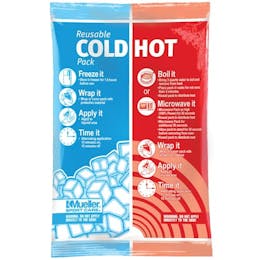
Reusable gel pack can be used either warmed in boiling water or frozen in the freezer

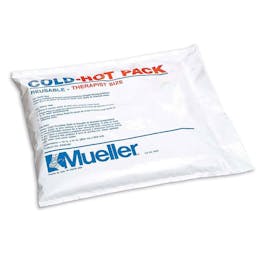
Reusable pack can be frozen or placed in boiling water to treat multiple injuries

Ideal for repeated use on soft tissue injuries (cold) or ongoing chronic injuries (hot)

Market leading reusable gel packs deliver effective hot and cold therapy

Reusable gel packs can be frozen or microwaved depending on the therapy requirement

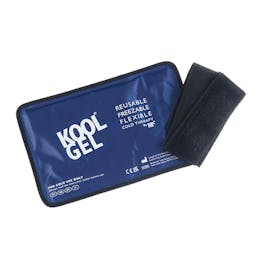
Flexible cold therapy treatment perfect for treating a wide range of minor injuries

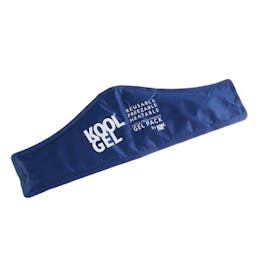
Specially designed to wrap around the neck providing targeted relief and maximum coverage

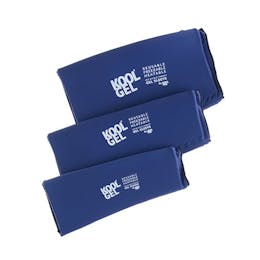
Flexible 360° treatment perfect for treating a wide range of minor injuries

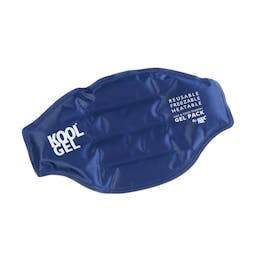
Conforms to the curvature of your back providing targeted relief and maximum coverage

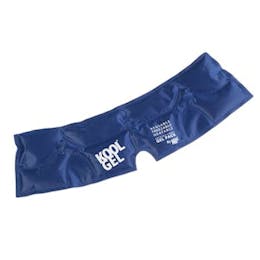
Specially designed to cover the critical areas of the head providing precise relief


For the secure application of hot or cold therapy to small body parts or limbs


Large adjustable wrap holds one hot/cold pack in place on larger body parts or limbs

Koolpak has been manufacturing Hot & Cold Therapy products since 1993 and has established itself as the UK’s #1 brand.
Instant Ice and Hot Packs are used for treating a wide range of soft tissue injuries, therefore these products must be certified as Class IIa Medical devices and accredited to ISO13485:2016, as required by Medicines & Healthcare Products Regulatory Agency (MHRA).
All Koolpak products are certified Class IIa devices, as required by MHRA. You're using a product that meets the highest medical standards for your well-being.
Unlike many other products on the market, Koolpak medical devices are fully CE compliant.
What is 'PRICE' (protection, rest, ice, compression, and elevation) Therapy?
For minor injuries such as sprains or strains, the below advice is normally effective for pain relief and recovery. PRICE therapy is suitable for initial treatment of injuries and can be used at home for two-three days after the initial injury. PRICE stands for Protection, Rest, Ice, Compression and Elevation.
Protection
Protecting the area from further injury is extremely important. When we are injured, we will not have our full range of movement which will likely make us a little clumsier. Using a support and being extra careful will ensure that your injury does not get worse.
Rest
Avoiding exercise and reducing your daily physical activity will help speed up your recovery. If you absolutely must move, consider using an aid to make sure you don't put undue pressure on the injury. A walking stick may help for leg injuries and a sling may help for arm and shoulder injuries.
Ice
Applying an ice pack to the injured area for 15 - 20 minutes every 2 - 3 hours will help ease the pain by numbing the nerve endings and help reduce swelling in the area. We recommend Koolpak Instant or Reusable Ice Packs with an Ice Pack Cover to prevent the pack touching your skin which can lead to irritation and ice burn.
Compression
Using an elasticated compression bandage on the injury helps to limit swelling and will ease pain. Compression bandages come in a variety of sizes, so make sure you use one that is the right size. Too small and the bandage could do more harm than good.
Elevation
Keeping the injured body part elevated above the level of your heart will help reduce swelling and help speed up recovery.
When To Use Hot Or Cold Therapy
For relieving muscle pain, loosening stiff joints and relaxing tense areas of the body, try:
Dry Therapies
- Heating pads
- Dry heating packs
- Electric heating wraps
Moist Therapies
- Hot tubs
- Steamed towels
- Moist heating packs
Hot Therapy Properties:
- Chronic injuries
- Dilates blood vessels to increase blood flow
- Removes waste materials from muscles
- Back pain, arthritis, stiffness

When To Use Hot Therapy
- Muscle Relaxation and Chronic Pain: Heat therapy is effective for relaxing muscles and alleviating chronic pain conditions. Applying heat increases blood flow and oxygen delivery to the affected area, which promotes muscle relaxation and reduces stiffness. This makes heat therapy a valuable tool for managing conditions like chronic back pain or muscle tension.
- Pre-Exercise Warm-up: Using heat therapy before physical activity can enhance flexibility and performance. Pre-exercise heat application is shown to positively influence muscle function and range of motion, preparing the body for more strenuous activity.
- Joint Stiffness: Heat therapy is particularly beneficial for managing joint stiffness, especially in conditions such as osteoarthritis. By increasing blood circulation and relaxing the surrounding muscles, heat improves joint flexibility and reduces the discomfort associated with stiffness.
For reducing inflammation, numbing sore tissues and minimising tissue damage post-injury, try:
Localised Therapies
- Ice packs
- Ice massages
- Cold compresses
Regional Therapies
- Ice baths and cold plunges
- Cold showers
- Cryotherapy chambers
Cold Therapy Properties:
- Acute injuries
- Constricts blood vessels to reduce swelling
- Numbs pain
- Bruises, headaches, swelling

When To Use Cold Therapy
- Acute Injuries and Inflammation: Cold therapy is effective immediately after an injury. It helps reduce pain and swelling by constricting blood vessels, limiting blood flow to the affected area, which in turn minimises inflammation. Research consistently supports the use of cold therapy for managing acute injuries, making it a key component of early injury treatment.
- Post-Exercise Recovery: Applying cold therapy after intense physical activity can help minimise muscle soreness and accelerate recovery. Studies show that cold-water immersion and similar cold treatments are beneficial in reducing exercise-induced muscle damage, thereby aiding in quicker recovery times.
- Migraines and Headaches: Cold therapy, often in the form of cold packs or compresses, can be effective in relieving migraines and tension headaches. Research indicates that cold therapy can help manage headache symptoms by numbing the pain and reducing inflammation in the affected areas.
Hot & Cold Therapy (aka 'Contrast' Therapy)

Contrast therapy involves alternating between hot and cold treatments on a specific area of the body to enhance recovery and overall well-being.
This technique can be applied in various ways, such as switching between hot and cold showers, combining a sauna session with an ice bath, or using a hot pack followed by a cold one.
For optimal results, it’s generally recommended to begin and end with a cold treatment, particularly if you're addressing inflammation and swelling. However, some prefer to conclude with heat to finish on a more relaxing note. The key is to experiment and find the routine that works best for your specific needs.
Benefits:
Contrast therapy combines the advantages of both hot and cold treatments, offering a wide range of benefits, including:
- Pain Relief: Eases discomfort in muscles & joints.
- Improved Circulation: Enhances blood flow, promoting better oxygen delivery to tissues.
- Reduced Inflammation: Helps decrease swelling and inflammation, especially after intense activity.
- Accelerated Recovery: Speeds up the healing process, making it an excellent post-exercise routine.
- Increased Energy and Mood: Boosts overall energy levels and enhances mood.
- Enhanced Mental Clarity: Improves mental sharpness and alertness.
- Increased Range of Motion: Helps maintain or improve flexibility and mobility.
When to Use Hot & Cold (Contrast) Therapy
Contrast therapy is particularly beneficial in several scenarios, often offering greater advantages than using heat or cold therapy alone:
Muscle Recovery and Performance Enhancement
This therapy is especially effective for post-exercise recovery. The alternating heat and cold treatments enhance circulation, reduce muscle soreness, and promote faster recovery compared to using just heat or cold therapy on its own.
Inflammatory Conditions and Joint Discomfort
Contrast therapy provides a comprehensive approach to managing inflammatory conditions and chronic joint discomfort. Cold therapy helps reduce immediate swelling, while heat therapy supports long-term joint flexibility and mobility.
Enhanced Circulation and Cardiovascular Support
For those aiming to improve blood circulation and cardiovascular health, contrast therapy offers a unique benefit. The alternating heat and cold cause blood vessels to dilate and constrict, creating a pumping effect that enhances overall circulatory function.
Reduction of Muscle Spasms and Tension
This therapy is also effective in alleviating muscle spasms and tension. The shift between hot and cold temperatures soothes muscle fibres, promoting relaxation and reducing tightness.
Hot/Cold Reusable
Hot and cold therapy packs are versatile tools for managing pain and discomfort, offering effective relief for a range of conditions from menstrual cramps to sprained ankles.
These gel-based packs are highly adaptable, providing either soothing warmth to improve circulation or cooling relief to reduce swelling.
The ease of use makes hot and cold therapy packs a popular choice for first aid kits in homes, workplaces, sports clubs, and hospitals. For safe application, it's recommended to use a protective sleeve to prevent skin irritation or burns. Simply pre-freeze or microwave the pack to create a cold or hot compress whenever needed.

A cold pack is ideal for quickly reducing pain, discomfort, and swelling from injuries like strains and sprains, helping to minimise tissue damage. A hot pack, on the other hand, delivers comforting warmth that can soothe menstrual cramps, arthritis, and muscle tension, with the protective sleeve ensuring a gentle barrier against direct heat.
These packs are not only versatile but also cost-effective, making them a valuable addition to any first aid kit. When used warm, they can enhance blood circulation, providing relief for muscle tension, arthritis, and general aches. As a cold compress, they effectively treat headaches, migraines, toothaches, and reduce swelling in sore muscles.
What is a hot and cold pack?

A hot and cold pack is a high-quality, reusable gel pack filled with a conductive liquid solution, designed to provide effective temperature therapy. The pack features a soft outer coating for optimal comfort, especially when applied to sensitive areas, and is constructed to minimise the risk of punctures, securely containing the gel inside.
These packs are long-lasting and versatile, allowing the internal gel to be reheated or frozen multiple times without losing its effectiveness.
Engineered for convenience, hot and cold packs can be quickly heated in a microwave or hot water, or stored in the freezer, ready for use whenever an injury occurs.

The Science Behind Hot and Cold Packs
Reusable hot and cold packs contain a solution of water and a non-toxic, viscous gel that efficiently conducts and retains heat or coolness throughout the pack.
This gel-water mixture enables the pack to maintain its temperature for extended periods, outperforming ice in terms of duration.
When frozen, the gel helps the pack stay colder longer than traditional ice packs and allows it to reach freezing temperatures more quickly. Typically, storing the pack in the freezer for just 1-2 hours is sufficient to achieve the desired temperature for reducing swelling or alleviating pain.

Similarly, when heated, the gel-water combination rapidly absorbs and distributes heat throughout the pack.
This gel component retains warmth longer than water alone, making it particularly effective for heat therapy.
The gel also gives the pack a thicker consistency, allowing it to conform easily to the body's contours, whether used hot or cold, enhancing its effectiveness in targeting specific areas of discomfort.




